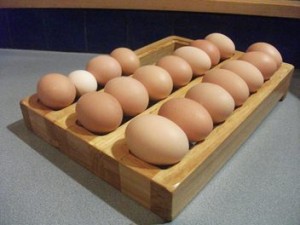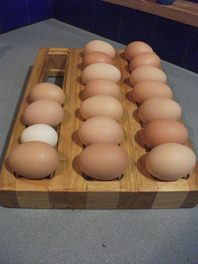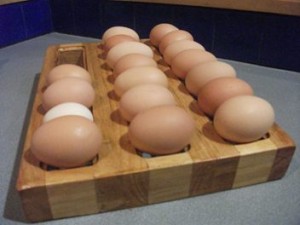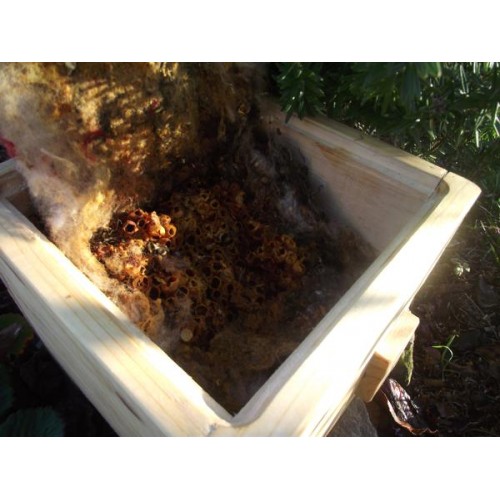The life cycle of lucerne leafcutting bees is quite different to that of honey bees. Leafcutting bees overwinter as hibernating fully-fed prepupae (= grubs), each in a cocoon surrounded by pieces of leaf. As temperatures rise in spring the prepupae gradually change into pupae and then into a male or female bee.
By about late October in warmer parts of the country the bees chew their way out, the sexes mate, and the females begin to search for blind-ended tunnels about 6 mm in diameter and 80-120 mm long in which to build new cells.
After cleaning the tunnels of loose debris females then carry in about 8-10 oval pieces of leaf cut from plants, which they stick together in the base of the tunnel to form a cup-shaped structure. The leaf pieces can be easily seen partly rolled up under the bodies of females as they enter their nesting tunnels. Once the cup is complete the females carry pollen in special hairs under their abdomen (the rear part of the body), into the nest tunnels, and the pollen is stored in the cup and is moistened with nectar. Like the leaf pieces, the pollen is very visible as the females enter their tunnels. An egg is then laid on the stored pollen and nectar, and the cell is closed with several circular pieces of leaf.
In sunny weather of about 20 degrees C or more, a female bee can make more than one cell a day, and in several weeks can fill a nest hole with 10-12 cells. She then may go on to make more cells in a second, and even a third nesting tunnel.
Within a couple of days the eggs hatch to small larvae (= grubs) which set about to eat all the pollen and nectar within about a week, after which they each spin a cocoon around themselves. If the cells are made before about the end of December, the fully-grown larvae may then develop straight into new bees which will emerge and re-nest that same summer, but if eggs are laid after the end of December, the great majority of progeny turn into the overwintering prepupae.
By about a few weeks after emerging the males have usually dispersed from the nesting site, but females will continue nesting until the end of March. Flowers favoured by females are the small pea-flower-shaped types such as lucerne, lotus and clover, but they will also readily visit many others, for example daisy-types, and our native Carmichaelias (native brooms), and various species of Hebe. Females prefer to forage on flowers very close to nest sites, so they often can be seen on flowers in the home garden. However if suitable flowers are not available nearby, females will fly up to a kilometre to collect nectar and pollen.
Females are said to be solitary nesters because they do not co-operate to make nests, and unlike honey bees there is no worker caste. However females like to make their nests in close proximity to other nesting females, so the species is said to be gregarious. This characteristic means that when bees emerge for the first time, most females will tend to nest back in the holes they emerged from or close by, so that nesting populations tend to persevere from year to year.
However, not all females make cells that grow live prepupae because of perhaps a failure to lay eggs, and in addition there is a very small native parasitic wasp only 1 mm long that can kill larvae and overwintering prepupae. The result is that nest tunnels gradually become clogged with leaves and old cocoons, so best management practice is to take apart the nesting tray’s any time between April and about September, and remove old nesting material, so that the females that emerge during the coming nesting season have clean tunnels in which to build new cells.
The suggested 50 cells to be placed within the solitary bee house should produce about 30 males and 20 females, but because the cells can’t be sexed, the numbers of each sex may vary. Of the 20-odd females, perhaps about half should establish nests in the solitary bee house, but depending on a number of factors such as the weather at the time of emergence, and the particular location of the solitary bee house, some females always migrate to look for nest sites elsewhere. Old sheds with nooks and crannies that might be of the right size for a nest can be particularly attractive. If some females do make nests elsewhere, this is not bad news because some new females that hatch from these nests may well find their way back to the solitary bee house, consider providing an additional solitary bee house in another area of your garden or property to increase numbers.
Solitary bee houses should be sited in a sunny spot and anywhere from just above the ground to about head-height. The more isolated the solitary bee house is from buildings and shrubs etc. the less likely emerging females will be attracted away to search for nest sites elsewhere. A concrete path leading to a clothesline in the middle of a lawn will provide both isolation, and sunbathing sites for females who love to warm up on sun-baked surfaces.
Yes, females do have stings, but the stings are only ever used if and when a bee somehow is accidentally pressed against the skin, and the sting is very mild compared to that of a honey bee. Also the sting has no barbs so it doesn’t stick in the skin. Stings are so infrequent and are of such little consequence that nobody working with the bees ever wears protective clothing.
All-in-all the characteristics of the leafcutting bee mean that it is a fascinating insect to have nesting on a property because the females can be safely observed by all and sundry as they go about their foraging and nesting activities. Also of course, they provide pollination for a wide range of plants both introduced and native.
Dr Barry J. Donovan, Entomologist.
20 July 2012.
Creative Woodcraft – Bee Products




